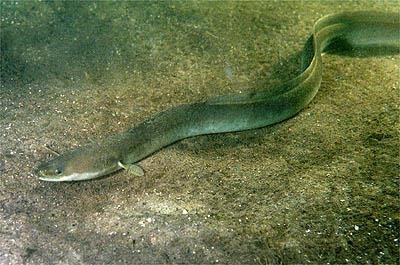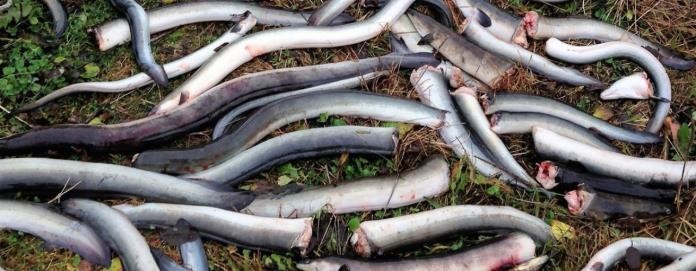EAA position statement
On the rebuilding of the European Eel (Anguilla anguilla) stock
February 2023

European eel
https://commons.wikimedia.org/wiki/File:Anguilla_anguilla.jpg
The EAA calls for:
1. All anthropogenic impacts (e.g., caused by hydropower, pumping
stations, pollution etc.) that decrease the production and escapement of silver
eels should be reduced to – or kept as close to – zero as possible.
Eels must be prioritised, and the eel’s natural habitat range must once again
be made accessible via river restoration and installation of mitigation
techniques.
2. Stop all targeted fishing for eels, commercial as well as recreational, at
all its life stages, and compulsory release of all eel by-catches.
3. Fishing for eels and elvers should only
be allowed for research purposes (e.g., tagging and monitoring).
4. EAA does not accept that profiteering by private
hydropower companies should be put ahead of species conservation. EAA therefore
calls for the regulation and sanction of the operation of hydropower plants
rather than abandon natural eel habitats.
5. Stop all sale of eels.
6. Increased efforts with enforcement to
restrict illegal fishing and the sale of eel in all its life stages.
7. Increase research to find the specific area in the
Sargasso Sea that European eels breed, for that area to be protected.
* Minority statement by
the Deutscher Angelfischerverband (DAFV) in the context of the 2023 EAA
position paper on rebuilding of the European Eel stock:
The German Angling
Association DAFV supports the EAA calls no 4,6,7 that address non-fishery
impacts on the stocks but rejects a total fishing ban. The DAFV is convinced
that a well-controlled eel fishery along with restocking as recovery measure,
and a responsible eel aquaculture sector, provides significant benefits to the
eel stock recovery and its sustainable use. Prohibiting all eel fisheries will
likely boost the very lucrative, illegal market, and consequently create much
worse effects on the stock than a responsible and well-controlled market that
is compliant with the EU Eel Regulation 1100/2007. Read the full DAFV
position here.
Justification:
·
EAA believes that the European eel is threatened by extinction.
·
The recruitment of elvers has declined dramatically throughout the 20th
century. Alarmingly, elver numbers are now at only ca. 2 % of what they were in
the 1960-70s.
·
Elvers migrating from the Sargasso Sea are likely to be impacted for
unknown reasons.
·
Elvers caught in European rivers used for restocking is less than it
should be.
·
Elvers from European rivers are illegally exported to Asia in huge
numbers.,,
·
However, while there is evidence that translocated and stocked eel can
contribute to yellow and silver eel production in recipient waters, the
evidence of contribution to actual spawning is missing due to the general lack
of detailed knowledge of the spawning of eels.
·
In some areas, eels suffer from parasites Anguillicola crassus and/or
pollution from hazardous substances (e.g., dioxins, PCBs, PFAs),
which weaken or kill them before or during their migration to the spawning
grounds in the Sargasso Sea.
·
The species is fished at all its life stages.
·
In Europe there are more than a million man-made obstacles – dams, weirs hydropower – which make it very
difficult or impossible for eels and elvers to enter many rivers or to spread
through river systems and lakes. Man-made obstacles in the rivers force eels to
congregate in front of and behind the obstacles making them easy prey for
cormorants and other predators.
·
Hydropower delays or prevents eels from up-stream and down-stream
migration. In addition tens of thousands of eels are killed within hydropower
turbines every year by the blades

Eels killed within a hydropower
turbine
https://dafv.de/referate/aktuelles/item/178-tag-der-wanderfische
The EAA stresses
that:
·
Cutting from ICES’ latest advice of 3 Nov 2022:
“ICES advises that when the precautionary approach is
applied, there should be zero catches in all habitats in 2023. This applies to
both recreational and commercial catches and includes catches of glass eels for
restocking and aquaculture.”
For the first time ICES has included ecosystem considerations in its eel
advice:
“ICES advises based on ecosystem based management considerations
that:
-
all non-fisheries related anthropogenic mortalities should be zero.
-
the quantity and quality of eel habitats should be restored; this
includes restoring connectivity and the physical, chemical, and biological
properties of the habitats.”
·
ICES
concluded In a
technical evaluation of the Member States' implementation of the Eel
Regulation (November 2022)that no overall
progress had been made by Member States and highlighted the need for more
effort in addressing non-fisheries impacts.
·
Eels are
on the CITES list Appendix II since 2007and included
Appendix II of the Convention on Migratory Species (CMS).
·
Much more
needs be done to improve the eel habitats, including removal of or altering
obstacles in the eels’ migration routes.
·
Freshwater
habitats: The European Eel Management Plan
adopted in 2007, with regard to the freshwater
habitats, has not delivered as hoped for.
·
ICES finds
that the 40% ‘escape-to-open-sea‘ target in that Plan was set too low.
The 2023 eel management measures as agreed by the
Council meeting, 11-12 Dec 2022 include:
Recreational fishing: banned all year (marine, not freshwaters)
Commercial fishing:closure for any commercial eel fishing
activity to six months in marine and adjacent brackish waters in the
north-east Atlantic (including the Baltic Sea) and in the Mediterranean
(excluding the Black Sea) in a differentiated way to take into account different
migration periods in different sea basins. Hence, member states will be able to
adapt the closure period for different fishing areas, to take into account
their specificities as well as the temporal and geographical migration patterns
of eel at respectively the glass eel and silver eel life stage.
Download and read the
complete position statement here
References:
[i] It is classified as critically
endangered by the International Union for the Conservation of Nature (IUCN): www.iucnredlist.org/species/60344/152845178 ; And it appears on theEuropean Red
List of Freshwater Fishes:https://ec.europa.eu/environment/nature/conservation/species/redlist/downloads/European_freshwater_fishes.pdf
[ii] ICES 7 Nov 2018: “The annual recruitment of glass
eel to European waters in 2018 is 2.1% of the 1960–1979level
in the “North Sea” series and 10.1% in the “Elsewhere Europe”
series.The annual recruitment of young yellow eel to
European waters in 2018 was 29% of the 1960–1979 level.” https://ices-library.figshare.com/articles/report/European_eel_Anguilla_anguilla_throughout_its_natural_range/18633494
ICES 3 Nov 2022: “The status of European eel remains critical. Indices
of both glass and yellow eel recruitment strongly declined from 1980 to
2011. Index values correspond to the recruitment as a percentage of the
1960–1979 geometric mean. Glass eel recruitment in the “North
Sea” index area was 0.5% in 2022 (provisional) and 0.6% in 2021
(final). In the “Elsewhere Europe” index series it was 9.7% in
2022 (provisional) and 5.5% in 2021 (final).The yellow eel recruitment index
for 2021 was 19% (final) of the 1960–1979 geometric mean.Time-series from 1980
to 2022 show that glass eel recruitment remains at a very low level.”
[iii] Stein FM, Frankowski J, Nijman V, Absil C, Kranendonk I, &
Dekker W (2021). Chinese eel
products in EU markets imply the effectiveness of trade regulations but expose
fraudulent labelling. Marine Policy, 132, 104651.oi.org/10.1016/j.marpol.2021.104651
[iv] Nijman V, & Stein FM (2022). Meta-analyses of molecular seafood studies identify the global
distribution of legal and illegal trade in CITES-regulated European eels. Current
Research in Food Science, 5, 191-195. doi.org/10.1016/j.crfs.2022.01.009
[v] Europol (2022). 49 individuals across Europe arrested in major blow
to eels trafficking. www.europol.europa.eu/media-press/newsroom/news/49-individuals-across-europe-arrested-in-major-blow-to-eels-trafficking
[vi] PFAS, ‘per- and polyfluorinated alkyl
substances’; also ‘forever chemicals’: Ca. 12,000 different substances,
which don’t break down naturally. Some forms of PFAS can take over 1,000 years
to degrade. https://echa.europa.eu/hot-topics/perfluoroalkyl-chemicals-pfas
[vii] “…1.2 million barriers have fragmented European rivers for over a
century in many cases (AMBER project).” https://damremoval.eu/report-2021
[viii] European eel (Anguilla
anguilla) throughout its natural range - ICES
[ix] EU request for
technical evaluation of the Eel Management Plan progress reports - ICES
[x] CITES: the Convention on International Trade in Endangered Species
of Wild Fauna and Flora https://ec.europa.eu/environment/cites/pdf/cop17/eels.pdf
About CITES Appendix II (trade ban or strict
restriction): https://cites.org/eng/disc/text.php#II
[xi] https://eur-lex.europa.eu/legal-content/EN/TXT/HTML/?uri=CELEX:32007R1100&from=EN
[xii] www.consilium.europa.eu/en/press/press-releases/2022/12/13/council-approves-fishing-opportunities-for-2023-in-eu-and-non-eu-waters/